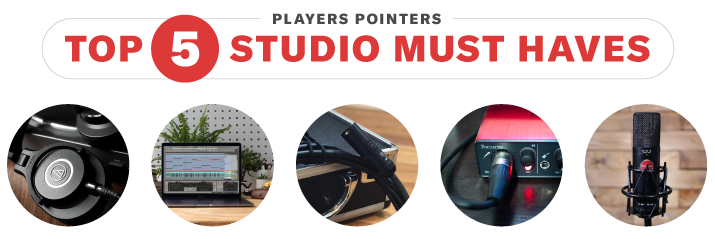
The digital age has turned every aspect of the music world on its head. Maybe the greatest example of this is in how we create and distribute music. Today, anyone is capable of recording and releasing music in a manner that was once reserved solely for label-backed artists. And while there are many facets to recording and releasing music on your own, this new age process often begins in a home studio.
For music makers of all skill levels and backgrounds, home studios are so convenient and cost effective it's hard to justify not having one. If you're imagining large scale construction with glass windows dividing rooms, closet vocal booths outfitted with sound proofing, or large mixing consoles reminiscent of NASA flight command—take a breather. The DIY approach is much, much simpler, and the results can get pretty darn close to professional.

This one is obvious, but also the most important. Many modern computers come equipped with recording software, often known as a digital audio workstation (DAW). If you don’t already have a DAW, you can find one free online, or purchase one with professional capabilities for a reasonable price. Ableton and Garageband are awesome choices for those just getting started.
There are also tons of online video tutorials to help you decide what’s best for you and to get you started making music quickly. Additionally, there is a wide world of offerings for loops and play-along tracks to bring the whole band to you. Toontrack is a great resource for those.

After your computer, the next most important element of the home studio is the audio interface. Typically connected to your computer through a USB, Firewire, or Thunderbolt connector, these hardware units allow you to plug microphones and instruments directly into them and control input/output levels. They also often have the added bonus of improved sound quality over your computer’s sound card. IK Multimedia’s iRig and Izotope’s new Spire unit are simple units that will get you up and running.
When purchasing, look out for the amount of inputs and outputs. If you’re recording drums, for example, you’ll want to spring for one that allows you to plug in more microphones simultaneously. Check out the Focusrite Scarlett interfaces for a wide range of I/O options.

Once you’ve got your recording rig set up, make sure you’ve got a good, working mic or instrument that can transmit sound cleanly. Though there are specialized instrument and mic cables which can go directly into a port on your computer, you will likely have better results using a standard ¼ or XLR cable into a digital interface.

Don’t forget – all of these exciting toys require supportive hardware and cabling. Having a spacious desk is really helpful, as well as something to support your instruments/mics, like stands. You’ll also need proper cables to connect your mic/instrument line, likely in the form of a ¼ or XLR cable. D’Addario American Stage Cables offer high quality in a variety of lengths to suit home studios of all sizes. If you’re using a digital audio interface, you’ll need to connect that to your computer, hopefully with an included cable. Lastly, you’ll need cables to connect the final must-have on the list — audio monitoring devices.

Surely your computer or device has speakers built-in, but if you want to give yourself a shot at creating something pro-level at home, it’s worthwhile to use studio monitors and/or headphones. Using studio monitors to hear playback is important to mixing and assures quality in your final product. Headphones are especially important when you’re recording with a mic and need to hear yourself as you’re playing. Without headphones, you may not be able to record effectively.
This is another reason that digital audio interfaces are important. Most digital audio interfaces allow you to run both monitor speakers and headphones, as well as adjust what you hear from each. Without a digital audio interface, you likely won’t be able to hook up speakers and headphones to record and listen to playback appropriately.
--
With a modest investment into these five must-haves, you'll be creating quality music in your home studio for years to come.